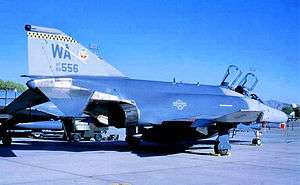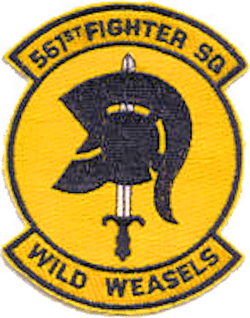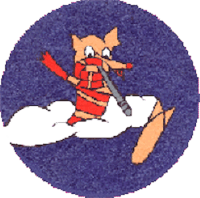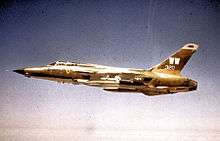561st Joint Tactics Squadron
| 561st Fighter Squadron | |
|---|---|
 | |
| Active | 1942-1996 |
| Country |
|
| Branch |
|
| Role | Tactics development |
| Part of | Air Combat Command |
| Garrison/HQ | Nellis Air Force Base |
| Nickname(s) | Smug Tigers (1953-1957) Black Knights |
| Motto(s) | Wild Weasel |
| Engagements |
World War II Desert Storm[1] |
| Decorations |
Distinguished Unit Citation Air Force Outstanding Unit Award with Combat "V" Device Air Force Outstanding Unit Award Republic of Vietnam Gallantry Cross with Palm[1] |
| Insignia | |
| 561st Joint Tactics Squadron emblem (approved 13 October 1993)[1] |
 |
| 561st Tactical Fighter Squadron emblem[note 2] |
 |
| 561st Fighter-Bomber Squadron emblem (approved 31 January 1955)[2] |
 |
| Patch with 561st Bombardment Squadron emblem[3] |
 |
The 561st Fighter Squadron is an inactive United States Air Force squadron, being last assigned to the 57th Operations Group at Nellis Air Force Base, Nevada. It was inactivated on 1 October 1996. The squadron was the last United States Air Force unit to fly the McDonnell F-4 Phantom II on operational missions. The last Republic F-105 Thunderchief shot down in the Vietnam War was from the 561st.
History
World War II
The squadron was first activated in 1942 as a Boeing B-17 Flying Fortress heavy bomber squadron and trained under II Bomber Command in Idaho, Utah and in Iowa.
It was initially deployed to Eighth Air Force in England, June 1943 at RAF Knettishall, England and entered combat in June 1943 by attacking an aircraft factory in Amsterdam. The squadron functioned primarily as a strategic bombardment organization in the European Theater of Operations until the war ended. Targets included industries, naval installations, oil storage plants, refineries, and communications centers in Germany, France, Poland, Belgium, Norway, Romania, and the Netherlands.
The squadron attacked many significant enemy targets, including aircraft factories in Kassel, Reims, and Brunswick; airfields in Bordeaux, Paris, and Berlin; naval works at La Pallice, Emden, and Kiel; chemical industries in Ludwigshafen; ball-bearing plants in Schweinfurt; and marshalling yards in Brussels, Osnabrück, and Bielefeld. Operations also included support and interdictory missions. Helped prepare for the invasion of Normandy by attacking military installations in France, and on D-Day struck coastal guns, field batteries, and transportation. Continued to support ground forces during the campaign that followed, hitting such objectives as supply depots and troop concentrations. Bombed in support of ground forces at Saint-Lô in July 1944 and at Caen in August. Covered the airborne assault on the Netherlands in September 1944 by attacking military installations and airfields at Arnhem. Aided the final drive through Germany during the early months of 1945 by striking targets such as marshalling yards, rail bridges, and road junctions.
Demobilized in England after V-E Day, aircraft flying back to the United States throughout the summer of 1945, station personnel sailing on the Queen Elizabeth from Greenock on 5 August 1945, and arrived in New York on 11 August 1945. A skeleton unit of the squadron was established at Sioux Falls Army Air Field, South Dakota, and inactivated there on 28 August 1945.
Air reserve
The squadron was activated in the reserves at Orchard Place Airport, Illinois on 12 June 1947 and assigned to the 338th Bombardment Group.[1][4] The squadron trained under the supervision of Air Defense Command (ADC)'s 141st AAF Base Unit (Reserve Training) (later the 2471st Air Force Reserve Flying Training Center), although it does not appear that it was fully manned or equipped.[5]
In July 1948 Continental Air Command (ConAC) assumed responsibility for managing reserve and Air National Guard units from ADC.[6] ConAC moved the squadron to General Mitchell Field, Wisconsin in September 1948 The 561st was inactivated when President Truman’s reduced 1949 defense budget required reductions in the number of units in the Air Force,[7] With the squadron's inactivation reserve flying operations at Mitchell ended until 1952, when the 438th Troop Carrier Wing was activated there.[1][8]
Cold War
In November 1953, the 561st Fighter-Bomber Squadron started flying North American F-86 Sabres at Clovis Air Force Base in New Mexico. The entire wing shipped to Europe during November 1954. Never out of action, the crisis in the Suez Canal area and the takeover of Hungary in 1956 provided flying time for the crews of the 561st out of Fürstenfeldbruck Air Base in Germany.
After the squadron completed transition training and became combat ready in North American F-100 Super Sabres, it was inactivated on 10 December 1957.
Vietnam War

The life of the 561st was resumed when the 23d Tactical Fighter Wing (also known as the Flying Tigers) renumbered its squadrons the 560th, 561st, 562d, and 563d Tactical Fighter Squadrons. The 561st, 562nd and 563rd deployed to SEA in 1965, the 561st being assigned to Takhli Royal Thai Air Force Base in Thailand and Da Nang Air Base in South Vietnam. "Wild Weasel" operations became the squadron’s primary mission in mid-1970, when the squadron exchanged its F-105B/D models for Republic F-105G Thunderchief]]s. On 4 April 1972 General Giap launched a three-pronged attack into South Vietnam with 200,000 troops and in April 1972, the 561st was deployed to Korat Royal Thai Air Force Base in Thailand from McConnell Air Force Base, Kansas immediately following a mobility alert. With only 69,000 American troops left on the ground in Vietnam, the US turned heavily towards air power. In his novel "Lawrence of Vietnam" Michael M. Peters, who served with the 561st, wrote "That's what war is like, you're heading towards hell, death and damnation and you're in a hurry to get there."
Throughout Linebacker I and Linebacker II, the 561st flew over 1,900 combat sorties accumulating nearly 6,000 combat hours, and was awarded the Air Force Outstanding Unit Award with Combat "V" for valor, a very rare award. The 561st also received the Vietnam Cross of Gallantry with Palm Unit Citation. Of the 200,000 invading North Vietnamese troops, 40,000 were killed, the North Vietnamese retreated back across the border and General Giap (who had defeated the French at Dien Bien Phu) was defeated by the US Air Force and was relieved of command.
From 18 Dec. to 29 Dec. of 1972 the Christmas bombing (called by the Americans the "Twelve Days of Christmas") forced the North Vietnamese to the negotiating table where they were made to sign the Paris Peace Accords, thus ending the war. A plane from the 561st was the last F-105 shot down in the Vietnam War (F-105G, 63-8359); it was hit by a surface-to-air-missile on 16 November 1972; the crew was rescued. The casualty rate for all Wild Weasel aircraft over the course of the Vietnam War was 63%. Of the 12 F-105G's assigned to the 561st during this time, four were shot down and one was lost to operational accident. One of the surviving aircraft from the original 12 airplanes of the squadron, S/N 63-8320, is on display at the National Museum of the United States Air Force; this plane is credited with three MiG kills in the Vietnam War. Wild Weasels became so effective in the Vietnam War that 90% of North Vietnamese radar sites would turn off if Wild Weasels were in the vicinity.
On 1 July 1973, the 561st moved to George Air Force Base and joined the 35th Tactical Fighter Wing. The 561st transitioned from the F-105/G when the base received its first shipment of the McDonnell F-4G Phantom II Advanced Wild Weasel in 1978.
Modern era
In August 1990, the Wild Weasels deployed to Sheikh Isa Air Base in Bahrain and during Operation Desert Storm flew over 2,400 sorties logging more than 8,000 combat hours. Inactivated at George after the war, and reactivated at Nellis Air Force Base on 1 February 1993, the 561st soon deployed to Incirlik Air Base in support of Operation Provide Comfort and returned to Southwest Asia at Dhahran Air Base in Saudi Arabia, supporting Operation Southern Watch and Operation Vigilant Warrior.
In 1994, the 561st became the largest fighter squadron in the United States Air Force. The 561st's presence over Iraq was continuous from just after the Iraqi invasion of Kuwait. Alongside their mission over Iraq, the 561st was also employed as an "Aggressor" squadron during RED FLAG exercises.
With the retirement of the F-4G Phantom II from the USAF on 26 March 1996, the 561st inactivated and the Suppression of Enemy Air Defenses mission was assumed by General Dynamics F-16 Fighting Falcons in different squadrons.
Lineage
- Constituted as the 561st Bombardment Squadron (Heavy) on 19 December 1942
- Activated on 24 December 1942
- Redesignated 561st Bombardment Squadron, Heavy on 20 August 1943
- Inactivated on 28 August 1945
- Redesignated 561st Bombardment Squadron, Very Heavy on 5 May 1947
- Activated in the reserve on 12 June 1947
- Inactivated on 27 June 1949
- Redesignated 561st Fighter-Bomber Squadron on 5 November 1953
- Activated on 23 November 1953
- Inactivated on 10 December 1957
- Redesignated 561st Tactical Fighter Squadron and activated on 1 May 1962 (not organized)
- Organized on 1 October 1962
- Redesignated 561st Fighter Squadron on 1 November 1991
- Inactivated on 30 June 1992
- Activated on 1 February 1993
- Inactivated on 1 October 1996
- Redesignated 561st Joint Tactics Squadron on 1 May 2007
- Activated on 22 May 2007[1]
Assignments
- 388th Bombardment Group, 24 December 1942 – 28 August 1945
- 338th Bombardment Group, 12 June 1947 – 27 June 1949
- 388th Fighter-Bomber Group, 23 November 1953 – 10 December 1957 (attached to 388th Fighter-Bomber Wing after 1 July 1957)
- Tactical Air Command, 1 May 1962 (not organized)
- 388th Tactical Fighter Wing, 1 October 1962
- 23d Tactical Fighter Wing, 8 February 1964 (attached to 41st Air Division, 6 March–8 July 1965)
- 832d Air Division, 1 July 1972 (attached to 35th Tactical Fighter Wing)
- 35th Tactical Fighter Wing, 15 July 1973
- 37th Tactical Fighter Wing, 30 March 1981
- 35th Tactical Fighter Wing (later 35th Fighter Wing), 5 October 1989 – 30 June 1992 (attached to 35th Tactical Fighter Wing, Provisional, 16 August 1990 – March 1991)
- 57th Operations Group, 1 February 1993 – 1 October 1996
- United States Air Force Warfare Center, 22 May 2007 – present[1]
Stations
|
|
Aircraft
- Boeing B-17 Flying Fortress, 1943–1945
- North American F-86 Sabre, 1954–1956
- North American F-100 Super Sabre, 1957
- Republic F-105 Thunderchief, 1964–1980
- McDonnall F-4 Phantom II, 1981–1992, 1993–1996[1]
See also
References
Notes
- Explanatory notes
- ↑ Aircraft is McDonnell F-4E-44-MC Phantom II, serial 69-7566
- ↑ This emblem was used by the squadron from about 1963, but apparently never officially approved until it was placed on a disc in 1993. Endicott, p. 864 (1993 emblem replaced 1955 emblem).
- ↑ Aircraft is Republic F-105G Thunderchief, serial 63-8320. This aircraft scored 3 MiG kills in Vietnam. It had been converted to a F-105G in 1972.
- Citations
- 1 2 3 4 5 6 7 8 Bailey, Carl E. (March 6, 2009). "Factsheet 561 Joint Tactics Squadron (ACC)". Air Force Historical Research Agency. Retrieved September 24, 2018.
- ↑ Maurer, Combat Squadrons, p. 660
- ↑ Watkins, pp. 76-77
- ↑ Maurer, Combat Units, pp. 217–218
- ↑ See Maurer, Combat Squadrons, p. 660. (No aircraft listed for squadron during this period).
- ↑ "Abstract, Mission Project Closeup, Continental Air Command". Air Force History Index. 27 December 1961. Retrieved March 24, 2014.
- ↑ Knaack, p. 25
- ↑ Ravenstein, pp. 234-236
- ↑ Station number in Anderson.
- ↑ Assignment data in Bailey, except as noted.
Bibliography
![]()
- Anderson, Capt. Barry (1985). Army Air Forces Stations: A Guide to the Stations Where U.S. Army Air Forces Personnel Served in the United Kingdom During World War II (PDF). Maxwell AFB, AL yes: Research Division, USAF Historical Research Center. Archived from the original (PDF) on January 23, 2016. Retrieved June 28, 2017.
- Endicott, Judy G. (1998). Active Air Force Wings as of 1 October 1995 and USAF Active Flying, Space, and Missile Squadrons as of 1 October 1995 (PDF). Air Force History and Museums Program. Washington, DC: Office of Air Force History. ASIN B000113MB2. Retrieved July 2, 2014.
- Knaack, Marcelle Size (1978). Encyclopedia of US Air Force Aircraft and Missile Systems (PDF). Vol. 2, Post-World War II Bombers 1945-1973. Washington, DC: Office of Air Force History. ISBN 0-912799-59-5. Retrieved December 17, 2016.
- Maurer, Maurer, ed. (1983) [1961]. Air Force Combat Units of World War II (PDF) (reprint ed.). Washington, DC: Office of Air Force History. ISBN 0-912799-02-1. LCCN 61060979. Retrieved December 17, 2016.
- Maurer, Maurer, ed. (1982) [1969]. Combat Squadrons of the Air Force, World War II (PDF) (reprint ed.). Washington, DC: Office of Air Force History. ISBN 0-405-12194-6. LCCN 70605402. OCLC 72556. Retrieved December 17, 2016.
- Ravenstein, Charles A. (1984). Air Force Combat Wings, Lineage & Honors Histories 1947-1977 (PDF). Washington, DC: Office of Air Force History. ISBN 0-912799-12-9. Retrieved December 17, 2016.
- Watkins, Robert (2008). Battle Colors: Insignia and Markings of the Eighth Air Force In World War II. Vol I (VIII) Bomber Command. Atglen, PA: Shiffer Publishing Ltd. ISBN 0-7643-1987-6.
External links
| Wikimedia Commons has media related to 561st Fighter Squadron (United States Air Force). |